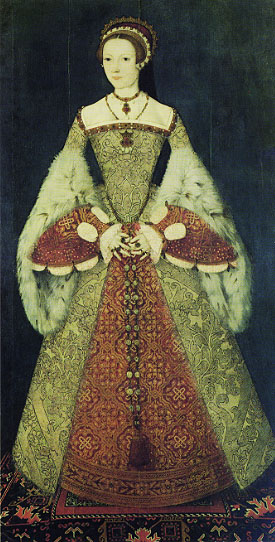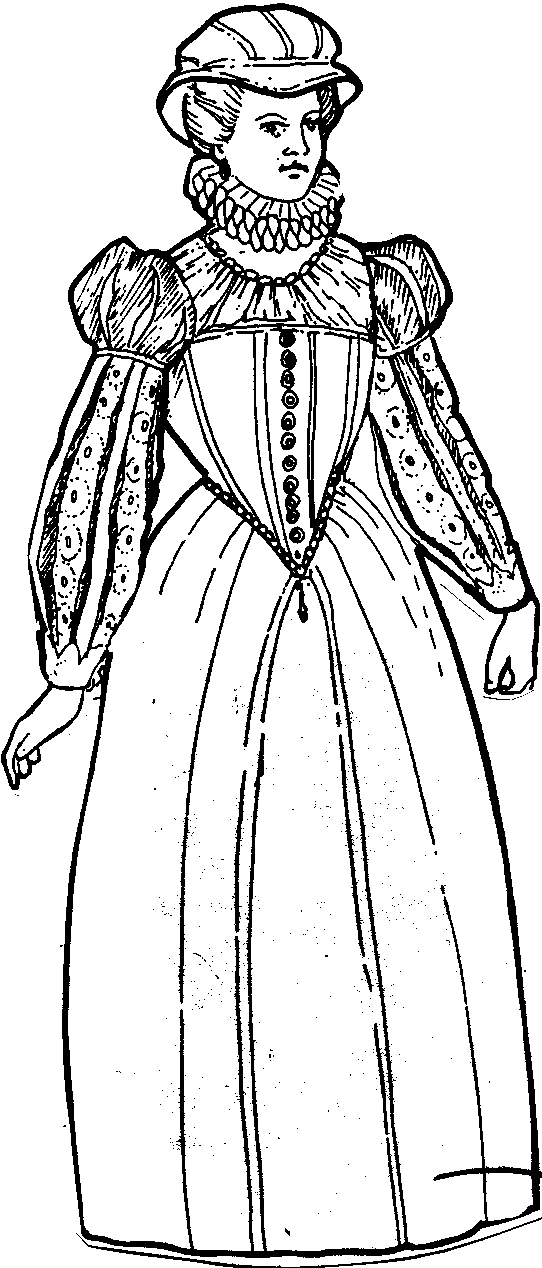

Of all aspects of Elizabethan culture, the most distinctive may well be its clothing. It was a highly fashion-conscious age, and prized a look that was elaborate, artificial, stylized, and striking. Men and women alike were concerned to be wearing the latest and most fashionable outfits, and although the clothes we associate with the Elizabethans were worn primarily by the upper classes, their fashions influenced ordinary people as well. Paintings that hung in the great country houses revealed the Elizabethan love of display in the minute details of splendid costume - both men and women portrayed in rich, heavy velvets and brocades thickly jeweled, of stiff and exaggerated shapes, set off by fine lace ruffs (pleated neck pieces) and cuffs.
 The well-to-do Elizabethan woman might have looked something like this: make-up
base of white lead and sulfur, various dyes on the cheeks, beauty spots drawn
on, eyebrows plucked thin, lips thickly lipsticked and hair powered, pinned
and perfumed.
The well-to-do Elizabethan woman might have looked something like this: make-up
base of white lead and sulfur, various dyes on the cheeks, beauty spots drawn
on, eyebrows plucked thin, lips thickly lipsticked and hair powered, pinned
and perfumed.
Elizabethan women wanted their clothing to look much like that of the men, with broad shoulders, wide hips, and slim waists.
Women's dresses were not made all in one piece as they usually are today. Instead, women wore two or more garments as one dress.
 The
BODICE came down to the waist;
The
BODICE came down to the waist;
The PARTLET or jewelry bodice had "wings" at the shoulders and came to a point at the waist.
The SLEEVES were separate from the bodice, but fastened to the bodice with laces. The sleeve was tight at the wrist, but otherwise full. Sometimes it was stuffed to keep its shape. RUFFSat the wrist (not shown) matched the RUFF at the neck area.
The KIRTLE, a skirt, was often of different material from the bodice. The framework underneath the kirtle was called a FARTHINGALE, made of wire or whalebone, allowing the kirtle to "balloon" out from the lower body. Some fashions included a BUMROLL (not pictured)a stuffed tube shaped item that added volume to the hip area, thus giving the wearer the appearance of a smaller waist.
HAIR was worn in many different styles, but always brushed back from the forehead. Women of the Elizabethan Age went through great extremes to achieve the look that was "in" They dyed their hair blonde, and sometimes wore quantities of peasants' hair, or strands of white or yellow silk.
The poorest class of women revealed no distinctive style, but a country maidservant might wear the bodice of her petticoat "laced before" and a blue or black kirtle.
Putting on an Elizabethan outfit was a major undertaking. With the many layers of clothing that were required for the complete look, it was thought that a women wearing the outfit would be very warm and most certainly uncomfortable! Wow! She must be stifling in that thing!